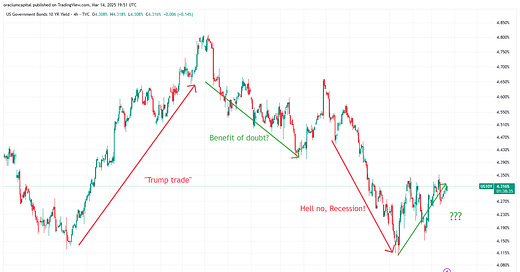Another week of selling. SPX is down 4% YTD, NASDAQ is down 8% YTD. Gold reached $3,000 per ounce. The fear was real this week. There was a lot of deleveraging and a lot of losses suffered by the major players in the market. ORCA turned out good this week (and is positive for the year!), but this is still very much a jumpy market, with huge implied volatility (i.e. option prices are immensely expensive), which we don’t usually like. But more on that on Tuesday. The point is, it’s one of those markets where it’s really hard to make money, even on the way down.
Having said that, we have been outlining the path here on this newsletter over the past few weeks.
On March 1st, while the SPX was at 5,960, we said to our paid subscribers that we are entering correction territory, and that:
Coming into next month, the smartest thing to do is to hold on to the hedges. The move is most likely not over yet. There certainly could be a pull-back (like yesterday at the close of day), but the trend (lower highs, lower lows) is down.
Last week, with SPX on 5,750 we doubled down, suggesting that some profits should be taken from the hedges but that this is not done yet:
…if you held shorts, taking profits would have been the smart thing to do.
Having said that, the selling is most likely not done. I would just wait for a few rallies to reengage the shorts. Don’t short the hole :)
On Tuesday we said that “Selling will continue until morale improves”.
Has moral improved now that we bounced off 5,500? Is the sell over? Or is it just over for now?
We tackle this issue in today’s newsletter.
The detox
Before we present our view, don’t forget what’s driving this decline. It’s not your average market correction. Treasury Secretary Scott Bessent made it clear in his CNBC interview this week that the US economy is going to have to go through a “detox period”.
He made a compelling point that markets and the economy have for too long been dependent on government stimuli (both fiscal and monetary) and that this entire situation is unsustainable. That is true, no doubt. I’ve talked about this kick-the-can-down-the-road scenario and this seemed to have become the consensus view: secularly low interest rates mean that we can keep refinancing debts at lower rates for as long as it takes. But interest rates are no longer close to 0. They seem to be on a structurally higher path, especially if inflation is not coming down that easily.
Higher interest rates present a huge burden on government budgets, and keep pushing debt up at higher and higher rates. This is a potentially dangerous cycle.
There is a narrative going around that the Trump administration wants to trigger a recession early, so that they can push interest rates and the 10-year yield down in order to make debt refinancing cheaper for the government.
However, thus far, we got a 10% correction in SPX from its peak just a month ago, and yet, the 10-year yield went up during that time, from 4.1 to 4.3%.
It’s not working quite yet. Even though rate cut expectations went down, the bond markets are not budging. A month and a half ago, it seemed like they were giving the new administration the benefit of doubt. Not anymore.
Which is why all eyes are now on the Fed, and the next FOMC meeting on Wednesday, March 19th.







